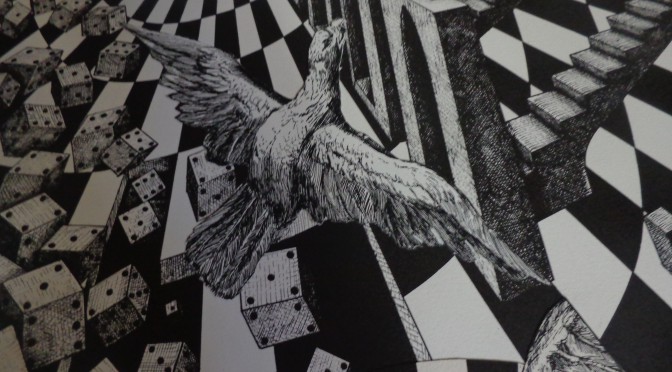Sequel of the preceding post Cosmogenesis (1) : From Myth to Myth
Chaos and Metamorphosis
The ancient Greeks had a great variety of myths relating to the history of the world. Although they all shared a language and a culture, each village, each tribe had its own beliefs, its own version of the Creation story and its own gods who were responsible for cosmic order.
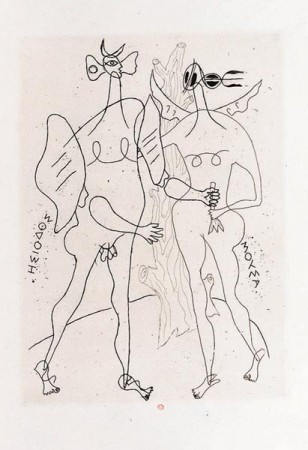
In this illustration by Georges Braque, Hesiod is seen receiving the torch of Hebrew tradition from Moses.
Hesiod, Theogony, Paris, Maeght, 1955.
Hesiod’s Theogony (8th-7th century BC) was the first attempt to synthesize these traditions, which probably dated back to the Assyrian and Babylonian civilizations. In recounting the stages in the emergence of the gods from primordial chaos Theogony offers an answer to the eternal questions of cosmogony: who created the world; what were the basic materials from which it was made; which came first, the gods, the stars or the elements?
Not only did Theogony have a strong influence on Greek thought, it also anticipated in many ways today’s theories of the origin of the world – particularly the idea of primordial chaos. Since the universe appears to have an ordered structure (albeit an imperfect one), it seems logical to regard the state which preceded the Creation as one of disorder and confusion. This notion has provoked greater controversy than almost any other in the history of cosmogony.
Ovid’s Metamorphoses also trawled Greek mythology, as well as Roman legend, in attempting to reconstruct the series of metamorphoses the world had undergone between the original state of Chaos and Julius Caesar’s supposed transformation into a star:
“Before the sea and the lands and the sky that covers all,
there was one face of nature in her whole orb
(they call it Chaos), a rough unordered mass,
nothing except inactive weight and heaped together
the discordant seeds of unassembled things.” [i]
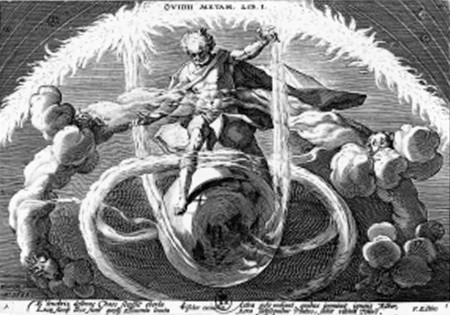
According to Hesiod the world was created ex vacuo, i.e. out of the void that existed before it, rather than ex nihilo, out of nothing. The distinction is fundamental. The standard Christian/Jewish interpretation of the Creation story in the Bible is that the world was created out of nothing, but the first few lines of Genesis, the Book of Job and the Second Book of the Maccabees give slightly different versions of the story – a discrepancy which has led to centuries of critical commentary. There are two possible interpretations of the scriptures: one that admits the pre-existence of some formless void [ii] and one that denies the existence of any matter before the Creation, the latter being the predominant belief in the Christian world today.
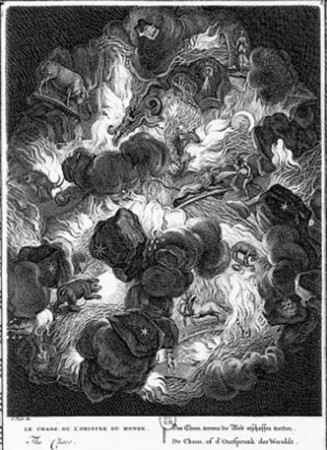
Le Chaos, ou l’Origine du Monde”, engraving by Picart. Paris, BNF
Modern historians have established that the Genesis story is a combination of two accounts written at different times. The later of these (Genesis 1 and 2, 1-4) was written after the flight from Israel and dates from the fifth or sixth century BC. Known as an elohistic text it tells that the world was created in six days by the Elohim, the seventh day being a day of rest. The earlier account dates from between the ninth and the sixth century BC and is a jehovistic text in that it is the story of Jehovah, the God of Israel, who created man and woman to inhabit an earthly paradise (Genesis 2, 4-25). The elohistic story echoes the Enuma Elish, the Babylonian epic (18th century BC), in which the Creation begins with a struggle between God the Creator (whom the Babylonians called Marduk, the Jews Jehovah) and Chaos. Like the bible story it describes the Creation as a sequence of increasingly complex developments.
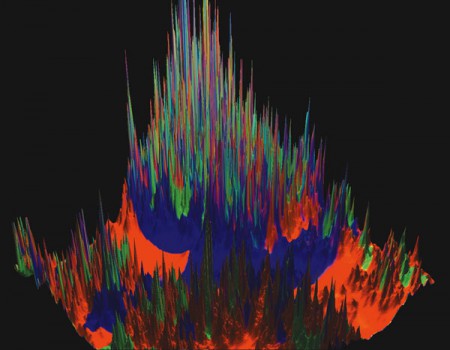
Computer simulation, @A. Linde, Stanford University
Quantum cosmology, which is now the most sophisticated scientific method of analyzing the history of the universe, is based on the general theory of relativity and quantum physics. It is an attempt to explain in mathematical terms how the universe suddenly emerged from the “quantum vacuum”. Quite different from the traditional concept of the primeval void, the quantum vacuum is like a virtual ocean whose surface is continuously agitated by ripples of energy. These ripples can spontaneously generate pairs of particles and antiparticles, which disappear almost as soon as they appear, leaving behind a sort of bubbling brew of energy, in constant flux, called the “space-time foam”. Occasionally the ripples create particles and antiparticles which are far enough apart not to cancel each other out. This is how matter emerges from the vacuum and how our entire universe could have arisen: from an ever expanding ocean of ripples.
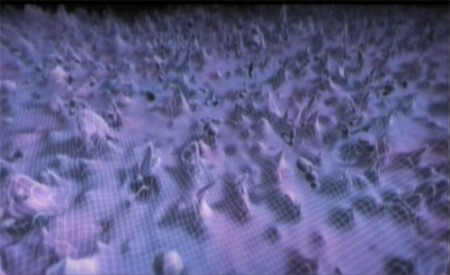
Notes
[i] Ovid, Metamorphoses, book I, translated by D. E. Hill, Aris & Phillips Bolchazy-Carducci, 1985, p. 13.
[ii] For example St Augustine, De Genesi Contra Manichaeos, book I, chapter iv.
******************************************************************
